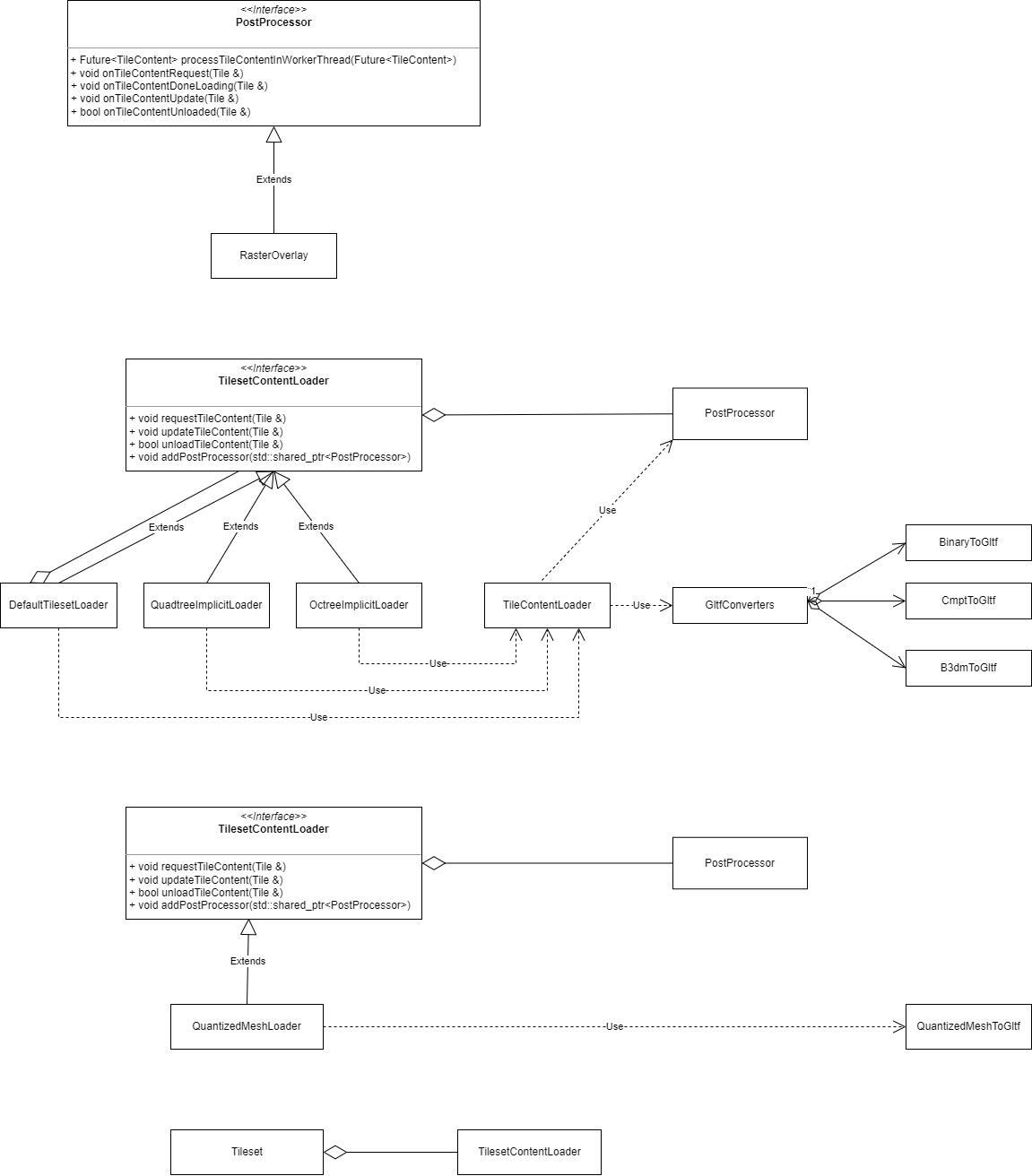Thanks for writing this up Bao! I need to read it in detail, but I noticed one problem in quick read:
Tile::requestContent() does upsampling for quantized mesh, but the code seems to never be used for normal tileset, implicit quadtree, and octree
Upsampling is only needed when raster overlays are attached. If you attach a raster overlay to a regular tileset.json-driven tileset, you'll see that upsampling happens for it, too. It's not specific to quantized-mesh at all.
Why we need to refactor our tile and tileset content loader?
Currently the code that loads tile and tileset json does quite many things which may not be related to each other. For example:
LoadTilesetDotJsonstruct is used to load tileset.json and layer.json formats, which are two different formats for 3D Tiles and Quantized Mesh respectivelyLoadSubtreestruct is used to load a subtree of implicit quadtree and octree format. However, at most, only one of them is used for the entire life cycle of the tilesetTile::requestContent()does upsampling for quantized mesh, but the code seems to never be used for normal tileset, implicit quadtree, and octree~ (Current implementation provides upsampling for all tilesets)TileContextstores some unrelated info for an external tileset. It stores the info of a normal tileset.json, a layer.json, a quadtree, and an octree. But at most, only one of them is usedImplicitTraversalUtilities::createImplicitChildrenIfNeeded()creates the children for a tile of quantized mesh, implicit quadtree, and octree.Tile::processLoadedContent()also create a tile's children in case it's a normal external tileset.json only. They have the same responsibility, but appears in different code pathThe state machine for keeping track of the tile loading process is leaked out to the Tileset class. This should be encapsulated within the tile itself, and never exposed to the client. Otherwise, we will never know who change the state of whom, and if not careful, will leak resources
What is the goal of the refactor?
Proposed architecture change
Diagram:
The plan is that we will have the
TilesetContentLoaderabstract interface with 3 methods:requestTileContent(Tile &tile)is for ... loading the content of a tile:TileContentLoaderhelper to convert those formats into a gltf. Layer.json loader will only need QuantizedMesh to gltf in its implementation since it doesn't deal with the rest.updateTileContent(Tile &)andunloadTileContent(Tile &). Another solution that I still keep thinking about is to usePostProcessorinterface which I will explain laterupdateTileContent(Tile &tile): When a tileset loader receives the content from the worker thread, it may choose not to propagate those contents to the tile immediately, but only when needed. That is the case for our current traversal. So this method is used to lazily propagate the content to the tile as we traverse down. Each type of the tilesets above can implement this function to create the children of a tile if neededunloadTileContent(Tile &tile): Currently in our implementation in theTile::unloadContent(), there is a code where it needs to wait for the children tiles finishing upsampling before allowing the tile content unloaded. But this code should be for Layer.json loader only. So there may be some divergences for different implementationsAs mentioned in the
TilesetContentLoader::requestTileContent(Tile &tile)above, there maybe duplications in different implementations when processing tile content in the worker thread and in the main thread as well, for example, drape raster overlay on an arbitrary tile. That's wherePostProcessorinterface comes in. The current code flow of drapping raster overlay on tile is that:Tile::requestContent(), it tries to map overlays to tile here. This happens before tile content is requestedMapRasterOverlayToTileeach frame which performs every frame.So
PostProcessorinterface is created to replicate this workflow above:void onTileContentRequest(Tile &tile)is called right before a Tile content is requested in the main threadvoid onTileContentDoneLoading(Tile &tile)is called right after the tile is moved to Done state. It's only called once during the entire cycle of content loadingvoid onTileContentUpdate(Tile &tile)is called every frame only after tile is moved to done and after the loader already updated the tile for the current frameprocessTileContentInWorkerThread()is called after the tileset loader finishes processing the tile content in the worker thread. I can imagine generate UV texture coordinate for Raster Overlay will happen here after upsampling or converting tile content to glTFA requirement for
PostProcessoris that we should never allow it to modify the Tile's State. Only Tileset Loader itself is the only one does that.We also need to automate the setup of
PostProcessor, so that implementation of TilesetContentLoader won't need to setup the processor itself. It also allows consistent behavior as wellAnother Benefits of the Changes
That's it for now. I'm still thinking about the design as we go on, so things will change though. I also know it requires massive change in the library itself, so it may not be planned soon or thing may not work as expected